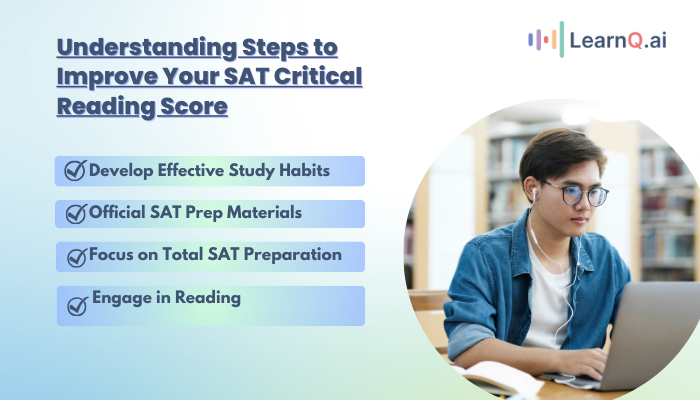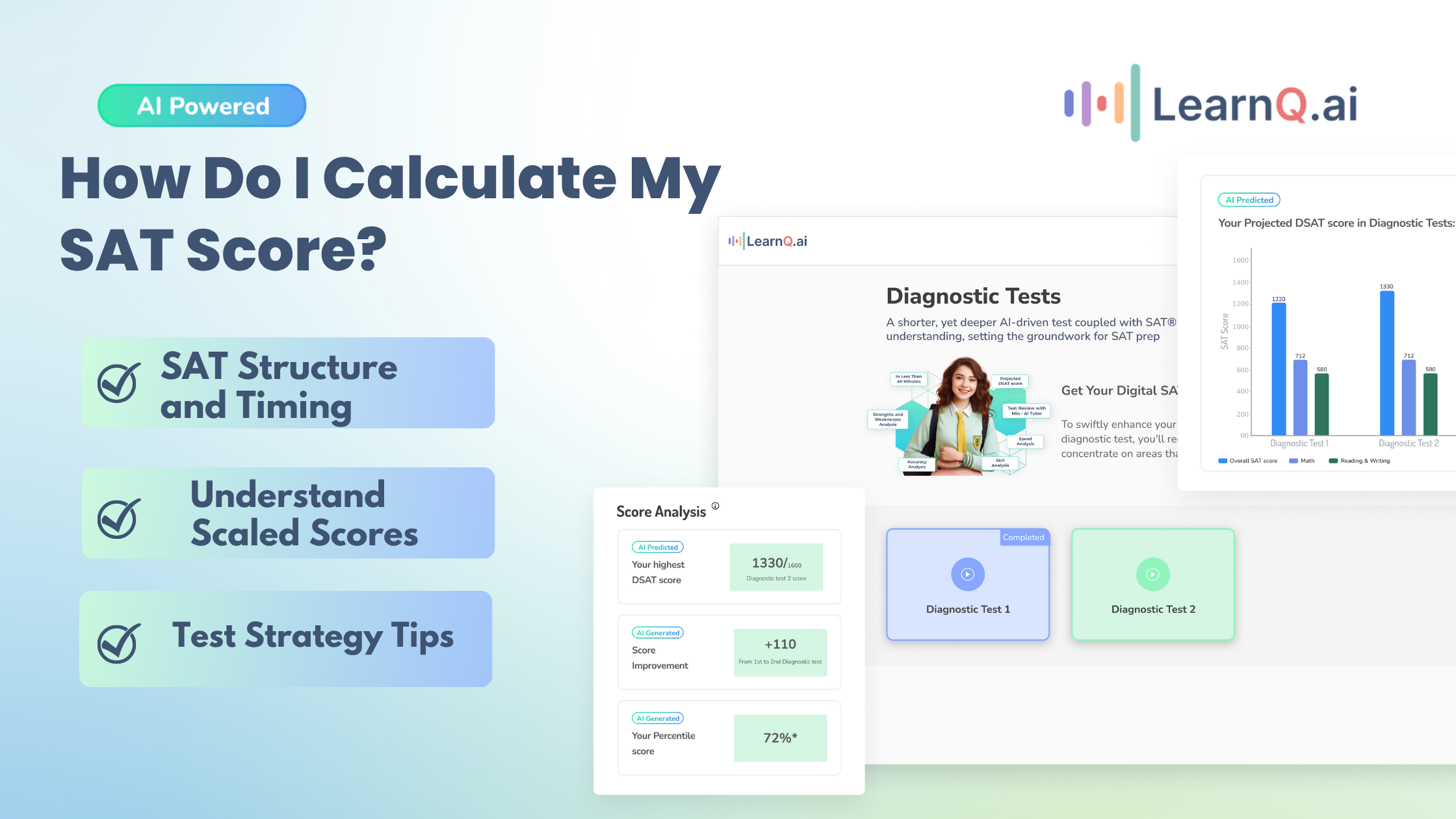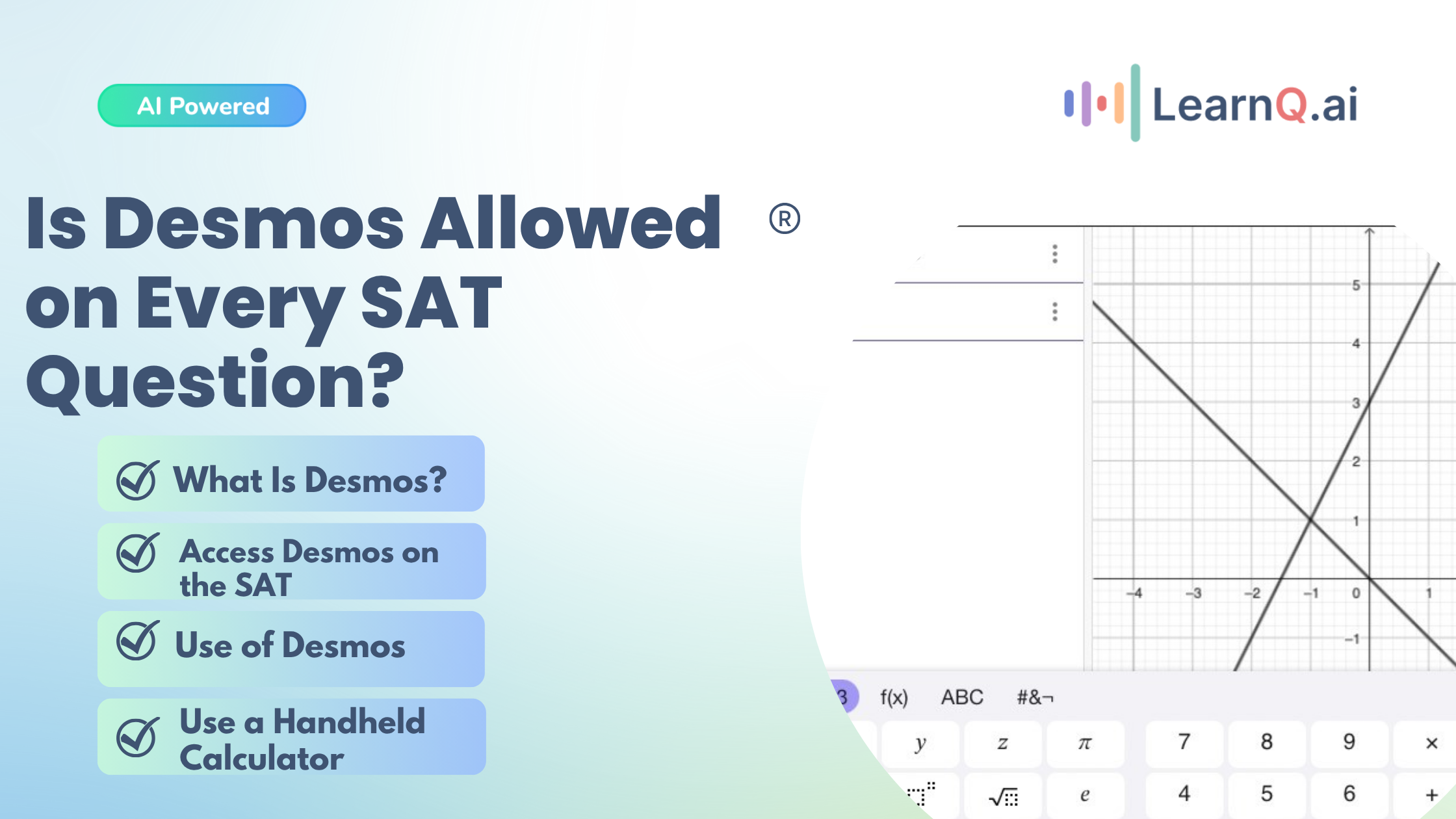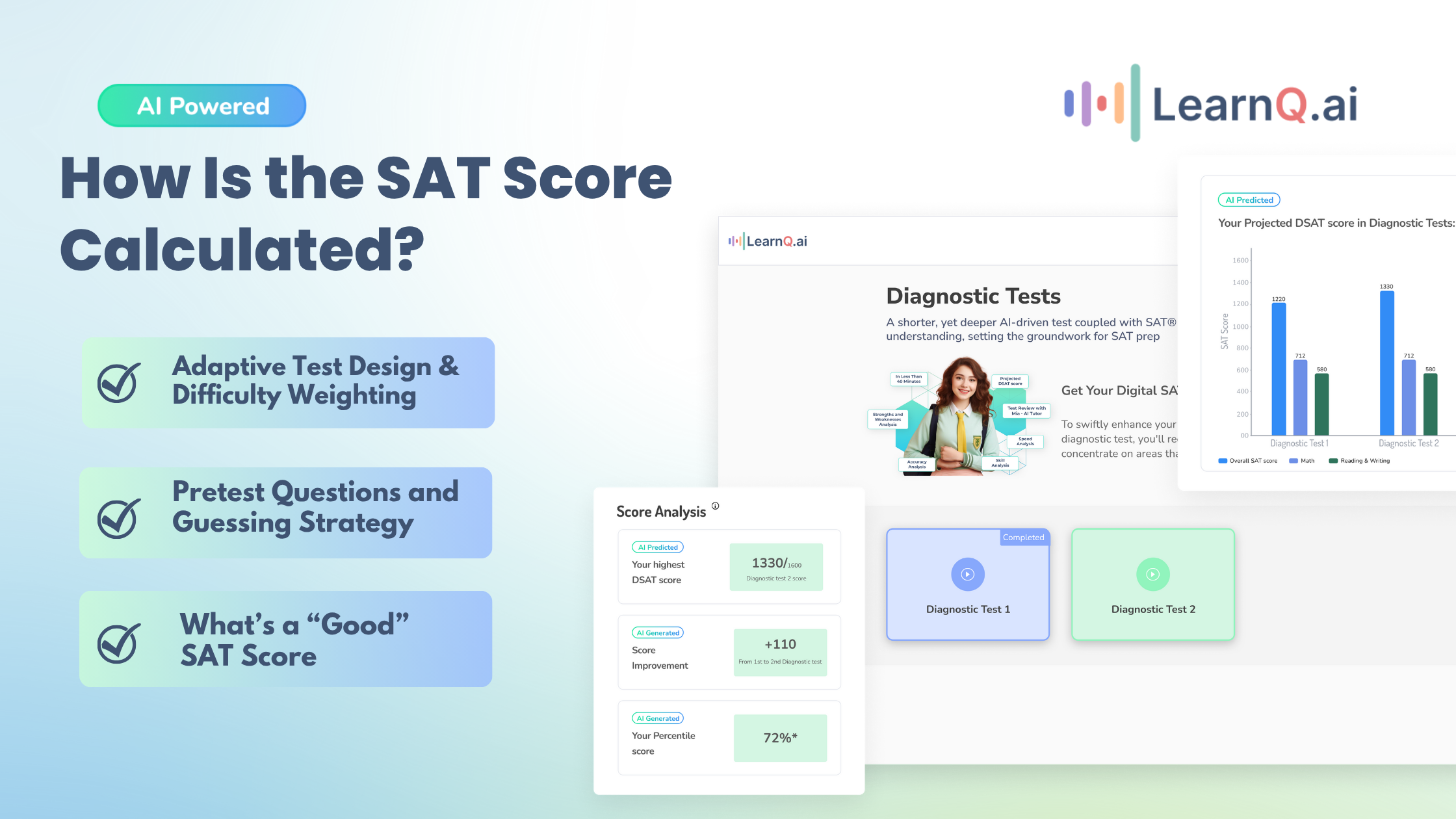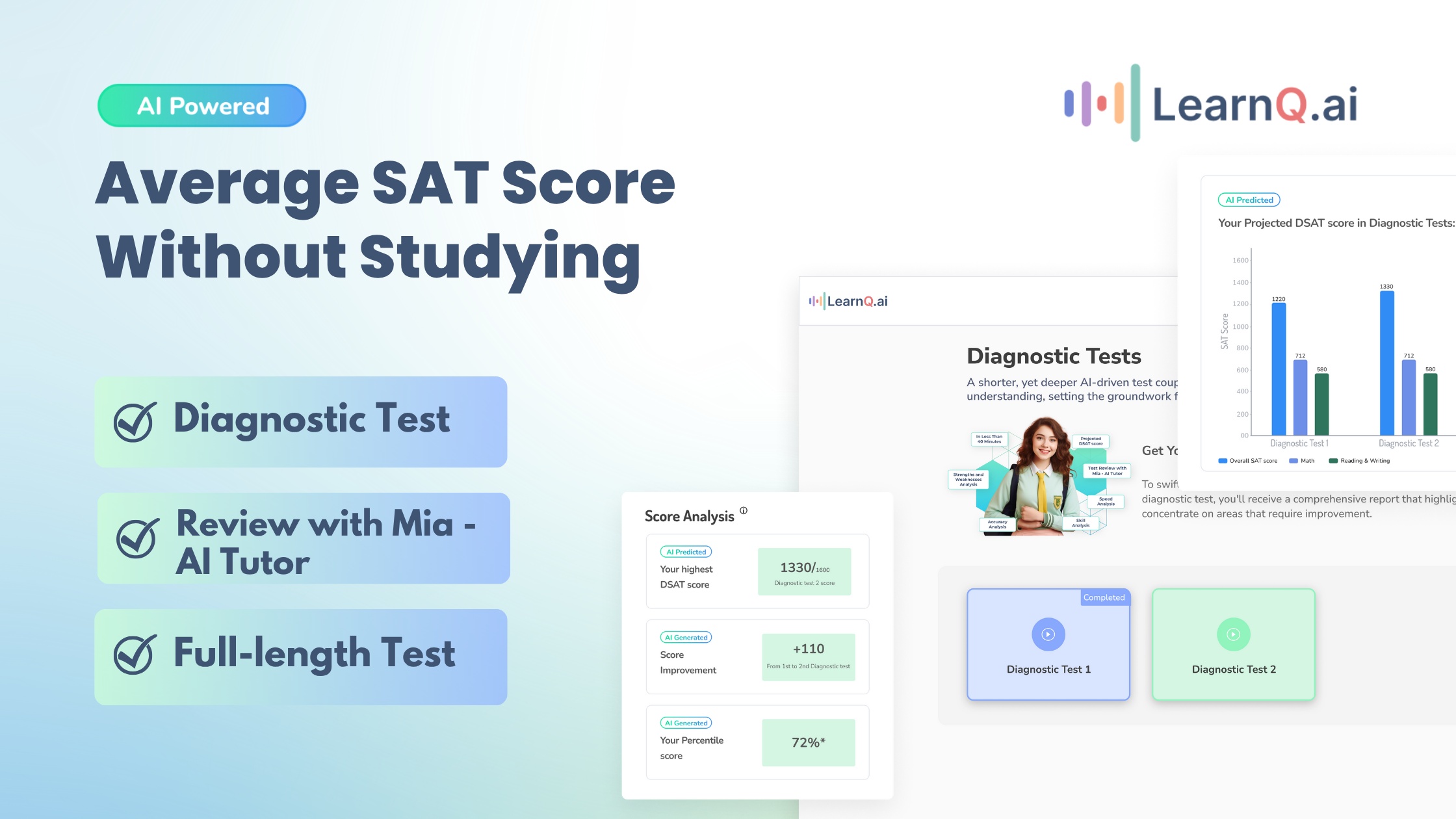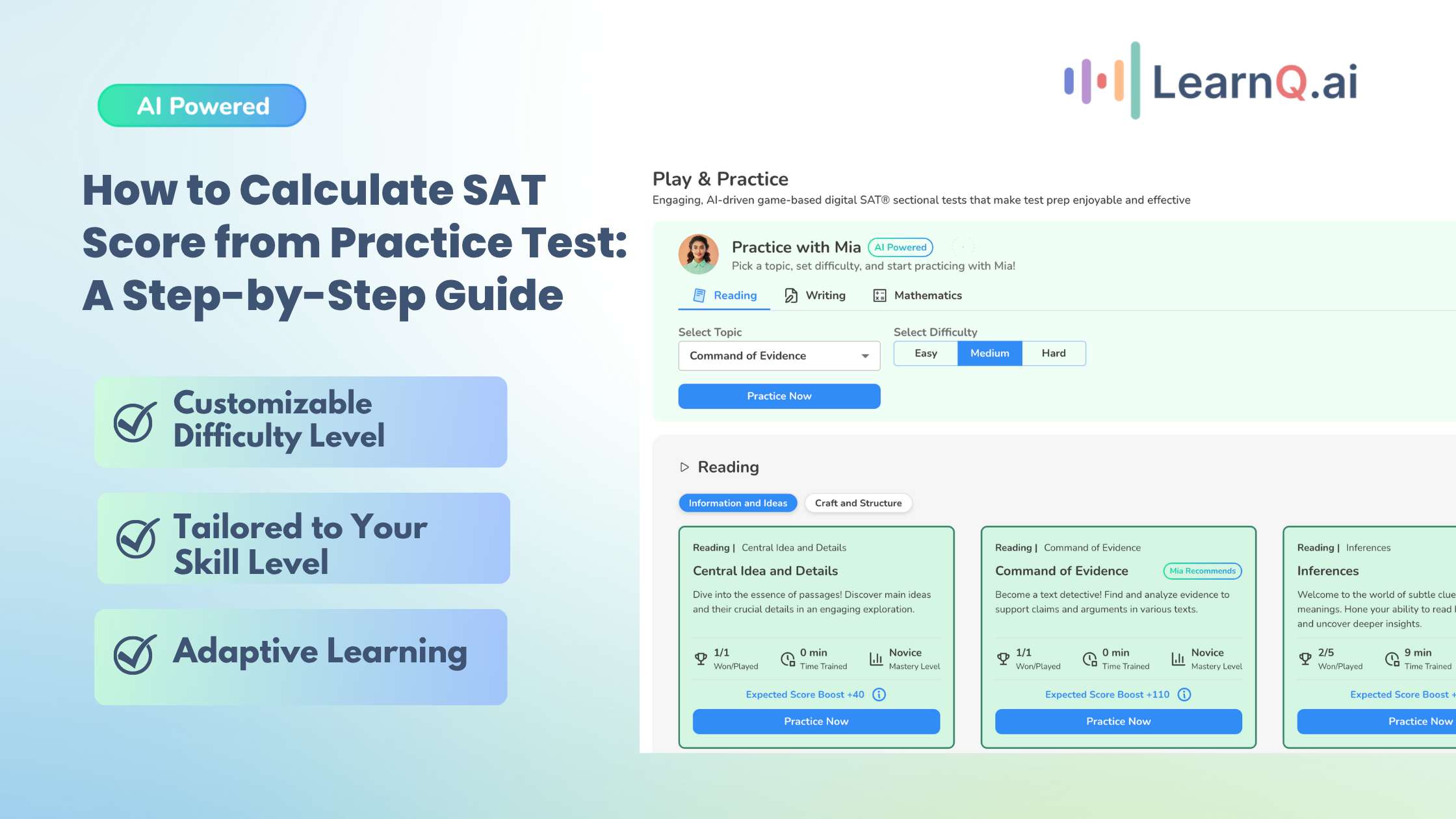The SAT Critical Reading score is crucial in determining your overall SAT score. Maximizing the SAT critical reading score can help you get into your desired colleges. The critical reading section evaluates your ability to understand and interpret complex texts, drawing on your analytical and comprehension skills. Because colleges use SAT scores as a key indicator of your academic potential, getting a good SAT critical reading score is crucial.
Improving your SAT critical reading score boosts your SAT performance and enhances your ability to tackle college-level readings and coursework. Developing these skills involves more than memorizing vocabulary words; it’s about understanding the nuances of language, recognizing the author’s intent, and making connections within the text.
LearnQ’s personalized digital tools are designed to optimize your SAT prep by tailoring study plans to your strengths and weaknesses. With AI-driven diagnostics, interactive lessons, and smart practice quizzes, LearnQ ensures that your prep time is spent efficiently, helping you maximize your SAT Critical Reading score.
In this blog, we will discuss six steps to improve your SAT critical reading score.
LearnQ.ai is Powered by VEGA AI—Is your Institute Next?
Give students a Duolingo-style test-prep platform with Shopify-level customization for tutors and institutes.
6 Steps to Improve Your SAT Critical Reading Score
Here are the steps you need to follow to improve your SAT critical reading score:
I. Embrace Active Reading Strategies
Improving your SAT Critical Reading score starts with adopting active reading strategies that sharpen your comprehension and time management skills. The key lies in these three core practices:
- Comprehend: Develop a habit of deeply engaging with each passage. Don’t just skim through; pause to analyze the main ideas, author’s tone, and underlying themes. Understanding the text at this level helps you answer questions more accurately.
- Contextualize: Many SAT questions hinge on understanding the context in which words or phrases are used. Practice reading texts like literature, historical documents, and scientific articles to improve your ability to deduce meaning from context clues. This strategy not only aids vocabulary questions but also enhances your grasp of nuanced arguments.
- Conquer: Time management is critical in the SAT Critical Reading section. Work on increasing your reading speed without sacrificing comprehension. Regular practice can help you efficiently identify the most important parts of the text, giving you more time to focus on complex questions.
To make the most of your preparation, leverage official resources. LearnQ’s adaptive digital SAT practice tests are designed to replicate the format and difficulty level of the real SAT. These tests give you a realistic feel of what to expect on test day and highlight your areas for improvement.
Educators can boost students’ SAT critical reading scores by teaching active reading strategies that keep them engaged and focused on comprehension. Encourage students to annotate passages by underlining key ideas, circling unfamiliar words, and making quick notes in the margins to summarize or question points as they read. This approach helps students process information actively, which is especially useful for tackling complex texts in the SAT.
Additionally, training students to identify the main argument and supporting details allows them to understand better the author’s intent and perspective, which are key aspects the SAT reading section often tests. By making these practices a habit, educators can help students develop a deeper, more analytical reading style that serves them well on test day.
Enhance your Digital SAT study routine with AI-driven insights and personalized practice tests.
Also Read: Tips for Solving Problems on SAT Practice Tests with Study Plan
II. Establish Robust Study Routines
Establishing a strong and consistent study routine is non-negotiable when boosting your SAT Critical Reading score. A regular study schedule helps reinforce reading skills and ensures that you’re continuously progressing.
- Consistency is Key: Commit to a study schedule that works for your lifestyle, whether dedicating 30 minutes daily or longer weekend sessions. LearnQ’s AI-driven planning tools can simplify this process by creating a personalized study calendar. These tools consider your current skill level, target score, and availability to provide a study plan that maximizes efficiency.
- Goal Setting: Setting clear, achievable goals is vital for staying motivated and focused. With LearnQ’s powerful analytics, you can break down your overall target into smaller milestones, such as improving your reading speed by a certain percentage or mastering specific questions. As you progress, use these analytics to track your performance, identify patterns, and adjust your study strategies accordingly. This adaptive approach helps you stay on course and ensures that your efforts yield the best possible results.
Establishing and following a robust study routine creates a structured environment where improvement becomes inevitable. LearnQ’s tools support you every step of the way, making your SAT prep journey efficient and goal-oriented.
Helping students create consistent and effective study routines can significantly improve their SAT critical reading performance. Educators can guide students in setting aside regular, focused time for reading practice, ideally at the same time each day, to reinforce discipline and reduce last-minute cramming.
Help students build a routine with LearnQ! Learn Q provides play and practice tests in a fun and engaging way, which can help students stick to the schedule more efficiently! Check out the Digital SAT questions provided by LearnQ!
III. Optimize the Use of Prep Materials
Engaging in purposeful and focused practice is one of the most effective ways to improve your SAT Critical Reading score. This means completing practice questions, reflecting on your performance, and learning from your mistakes.
- Practice with Purpose: Make it a habit to take LearnQ’s sectional tests in reading regularly. These tests are designed to mirror the SAT’s format and difficulty, giving you a realistic sense of what to expect on test day. By repeatedly exposing yourself to SAT-style questions, you’ll become more comfortable with the pacing and question types, reducing test-day anxiety and boosting your confidence.
- Deep Dive into Mistakes: The real magic of learning happens when you analyze what went wrong. LearnQ’s ‘Review with AI’ feature, powered by ‘Ask Mia,’ is an invaluable tool in this process. After each practice session, use this feature to dive deep into the questions you got wrong. ‘Ask Mia’ provides detailed explanations, helping you understand why an answer was incorrect and how to approach similar questions in the future. By identifying patterns in your mistakes and gaining insights into the SAT’s logic, you can systematically improve and avoid making the same errors.
With consistent and purposeful practice, supported by LearnQ’s advanced review features, you can transform your weaknesses into strengths and approach the SAT Critical Reading section with a strategic edge.
Educators can maximize students’ SAT critical reading improvement by teaching them to use prep materials strategically. Instead of passively working through practice tests, encourage students to review each question carefully, focusing on why certain answers are correct, and others are not. This reflection process helps them understand typical SAT question traps and develop strategies to avoid them. Educators can also introduce various resources, and platforms like LearnQ can help you access such resources.
Practice with full-length SAT practice sets and use the resources to improve your SAT critical reasoning score tremendously!
IV. Holistic SAT Preparation
While it’s cruciboostingCritical Reading score, a well-r is crucialounded preparation strategy is equally important. Success on the SAT requires a balance between all sections, and developing your reading skills can positively impact the board.
- Across the Board Balance: Don’t let your focus on Critical Reading overshadow other sections. LearnQ’s comprehensive resources ensure you are well-prepared for the SAT as a whole, covering Math, Writing, and Language sections. By dedicating time to each area, you maintain a holistic approach that prevents you from falling behind in any particular section, ultimately contributing to a stronger overall performance.
LearnQ’s adaptive learning platform supports this integrated approach, offering personalized recommendations that link skills across sections.
By maintaining a balanced preparation strategy and leveraging LearnQ’s synergistic resources, you’ll be better equipped to confidently tackle the SAT and achieve your highest possible score.
As an educator, you should create an effective and personalized student study plan. There are a lot of ways you can do that. Platforms like Vega.ai can make it easier for you to plan.
Also read: Strategic Steps: Tips & Templates for Effective Lesson Planning
V. Cultivate a Reading Culture
Expanding your reading horizons and building a robust vocabulary is key to excelling in the SAT Critical Reading section. By enEngaging various texts, yousharpen your comprehension skills and become more adaptable to the different types of passages featured on the exam.
- Diverse Reading: Don’t limit yourself to a genre or writing style. Reading a mix of fiction, non-fiction, science articles, historical texts, and editorials broadens your comprehension skills and exposes you to varied writing techniques. This versatility will make navigating the SAT’s complex and diverse passages easier. Practice reading with an active, analytical mindset, questioning the author’s purpose and argument to deepen your understanding.
- Vocabulary Expansion: A strong vocabulary is crucial for tackling SAT reading questions.To build a rich vocabulary, leverage LearnQ’s innovative ‘Text Adventure’ and ‘Language’ modes in its AI Tutor. These tools immerse you in diverse writing styles and expose you to high-frequency SAT vocabulary words in engaging ways. By encountering and learning words in context, you’ll improve your ability to interpret meanings and feel more prepared for vocabulary-driven questions.
By embracing diverse reading habits and actively expanding your vocabulary, you’ll be better prepared to handle the wide range of texts and questions the SAT Critical Reading section presents.
Enhance your Digital SAT study routine with AI-driven insights and personalized practice tests.
VI. Collaborative Learning
Preparing for the SAT Critical Reading section doesn’t have to be a solo endeavor. Engaging in collaborative learning and seeking personalized guidance can provide fresh perspectives and accelerate your progress.
- Group Dynamics: Participating in study groups or discussion forums within the LearnQ platform is an excellent way to deepen your understanding. Discussing passages and questions with peers allows you to see different ways of interpreting texts and analyzing arguments. This exchange of ideas can highlight insights you may have missed and improve your critical thinking skills. The collaborative environment can also motivate you and make the study process more enjoyable.
- Personalized Tutoring: Consider using LearnQ’s ‘Learn with AI Tutor for tailored and strategic support.’ This feature offers customized guidance based on your unique learning patterns, strengths, and areas that need improvement. The AI Tutor provides strategic advice, recommends practice activities, and adjusts your study plan as you progress. With this personalized approach, you can maximize your efficiency and focus on the strategies that will most impact your SAT performance.
Combining group study dynamics with individualized tutoring ensures a well-rounded and effective preparation strategy, equipping you with the tools to confidently tackle the SAT Critical Reading section.
Understand how to analyze your SAT scores; this will help you improve the scores of one section and your overall performance.
As an educator, you can Encourage students to join study groups or participate in discussion forums on platforms like LearnQ, where they can dissect passages, explore various interpretations, and analyze arguments with their peers. This kind of interactive learning sharpens critical thinking by exposing students to alternative viewpoints and analytical methods they might not consider independently.
Additionally, educators can introduce students to tools like LearnQ’s ‘Learn with AI Tutor,’ which provides targeted, personalized feedback tailored to each student’s progress and challenges. The AI Tutor adjusts recommendations based on performance, helping students focus on high-impact strategies and practice areas, making their preparation both efficient and effective. This blend of collaborative engagement and personalized guidance can foster a supportive learning experience that boosts students’ confidence and readiness for the SAT.
LearnQ.ai is powered by VEGA AI—Is your institute next?
Offer students a Duolingo-style test-prep platform with Shopify-level customization for tutors and institutes.






Conclusion
Improving your SAT Critical Reading score is crucial for excelling on the SAT and preparing for college’s academic demands. Mastering reading comprehension, vocabulary, and analytical thinking through strategic study routines lays a solid foundation for your academic future.
At LearnQ, we support your journey with personalized study plans and free diagnostic tests that assess your strengths and weaknesses. Our AI-driven tools offer real-time feedback and tailored practice tests, ensuring you’re always progressing.
Connect with other SAT Students Community, share tips, and learn together as you prepare. Get started with LearnQ.ai today to take your SAT preparation to the next level and build the skills necessary for college success.

